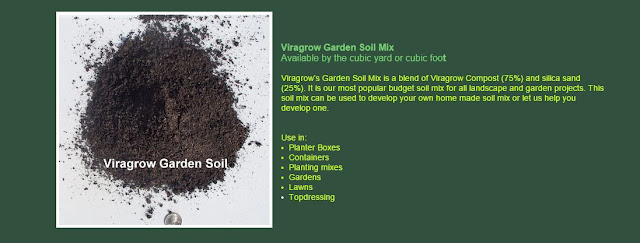Q. We recently purchased our house and are in the process of installing our backyard. Currently we are digging trenches for irrigation lines and very quickly finding out that this so called "soil" is in fact construction infill. The "soil" is comprised of dusty dirt and filled with rocks. Our landscape plans comprise of a small turf patch for our 1 year old daughter and our 3 year old dog, perimeter landscaping and a 18" wall off our patio for a small herb garden. We are have a very small yard and the finished landscape area, where soil will be placed, is only 365 sf. What do you recommend that we use in our yard to amend the infill and turn it into useful soil? And how much will we need?
A. What you are describing is pretty common in most urban
residential settings in planned communities. This fill will be okay for unplanted desert "flooring" of your landscape but will need to be
replaced if you are planting in the ground.
The other option is to do some
contouring and elevation changes of your landscape with decent quality
"topsoil". Viragrow has a source of local "topsoil" that is decent and can be used
for elevation changes in contouring at a fairly reasonable price.
I don't know
of another company in town that would have anything this good for that purpose.
You could also use soil mixes for doing the same thing but I think they'll be
more money. If you do any elevation changes to your landscape make sure that
water will collect in your landscape in low spots and not enter the home if
there is a heavy downpour.
Residential yards are required to have positive
drainage from the backyards to the city streets and ultimately into storm
sewers. This is to prevent this kind of thing from happening during the storm
so make sure you contour/elevation change so water does not enter your home.
If you are not doing any elevation changes and planting directly
into this fill, I would excavate this fill to these depths for the following
planting areas:
- flowerbeds and vegetable beds 12 to 15 inches
- small shrubs and groundcovers 12 to 15 inches
- larger trees and shrubs 18 to 24 inches
- fruit trees 18 to 24 inches
- lawns 12 to 15 inches
- vines 12 to 15 inches
Basically
the larger the plant, the deeper you should excavate to accommodate its roots.
Planting holes for woody
plants should have a width 3 to 5 times their depth. If you can remove rocks
from this fill larger than a golf ball and have enough soil remaining than I
would mix the soil 50-50 with straight compost for planting.
If it is mostly
rock and you don't have much soil left then I would bring in a soil mix such as
the Viragrow Garden Soil mix. This is a soil mix of silica sand and compost.
The amount you will need is a little bit tricky. You would need
12 yards to fill an area about 350 square feet to a depth of 12 inches. I'm not
saying that you need to order this amount but this should give you some idea of
your starting point and worst case scenario.
Order 100% or straight compost if you can mix it with native
desert soil. If you cannot mix it then I would order Viragrow's Garden Soil mix
as a general mix for planting all of your woody plants and lawn. You can always
add extra ingredients to this mix for your vegetable garden area or your
flowerbeds.





No comments:
Post a Comment